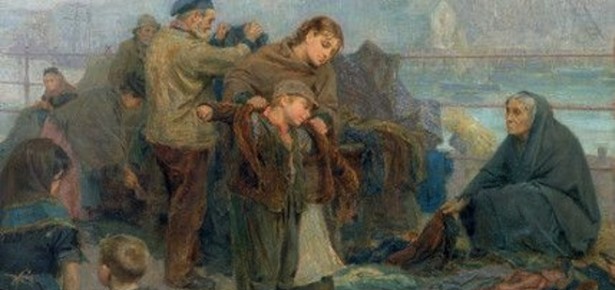
I have a life-long passion for clothes, and earned my living for many years as a seamstress. I am particularly interested in the relationship between clothing and identity, and this combined with a long-standing interest in working-class social and cultural history – as a child I would always choose stately homes for my birthday outings and head straight for the kitchens and servants’ quarters – and my family history, my mother being the descendant of London dock workers and dressmakers.
Men’s need to maintain a ‘respectable’ appearance at work meant their clothing took priority over that of their wives and children
Parameters and sources. The fact that there was no existing book on the subject offered a great opportunity, but also meant that the potential scope of the work was enormous, so setting parameters was a challenge. In fact, I didn’t actually realise the full extent of the potential scope when I started out (which was probably just as well).
As I researched I discovered numerous unforeseen factors that impacted on the dress of the poor – such as the ability to keep a pig for slaughter, which reduced expenditure on food and produced extra income from the sale of surplus meat, both of which potentially increased the money available for clothes. This had not crossed my mind when I began, and is the example I always relate to my students when trying to illustrate the unexpected, interesting, but often time-consuming, directions in which research can take you.
Closely allied to this was the question of sources. On the one hand, research into clothing the poor is limited by the dearth of extant garments. On the other, because so many people concerned themselves with the poor’s clothing, the variety of alternative sources seemed limitless – the records of charities and institutions, the evidence presented to parliamentary commissions, instruction manuals for schools, servants and employers, sermons and parish magazines, autobiographies and diaries, social commentaries and investigations, newspaper reports, costume books. So selection and interpretation were key.
I was particularly concerned to hear what the poor themselves had to say about their clothing – that their voices should not be overwhelmed by those of the numerous philanthropists and officials who sought to impose their own views about appropriate dress. Autobiographies were immensely helpful here.
This is one of the key themes of the book. The changes affected the style of garments worn, the fabrics from which they were made and the means by which they were acquired. During the century, the hard-wearing, often home-made, clothing suited to rural life and work, such as smocks and sunbonnets, was replaced by the closer-fitter, often more formal, and increasingly shop-bought garments deemed more appropriate for urban and industrial settings. Cotton yarn and cloth manufacture is inextricably associated with British industrialisation and during the nineteenth century cotton mostly replaced wool and linen as the fabric of working-class clothes. This was very contentious because although cotton was cheap and washable, it lacked the durability and warmth of linen and wool.
The rise of the male-breadwinner ideology that accompanied industrialisation also affected working-class dress. Men’s need to maintain a ‘respectable’ appearance at work meant their clothing took priority over that of their wives and children, but women’s responsibility for the rarely sufficient domestic budget left them with the decisions about what to go without when clothing had to be bought.
Although one of my main arguments is that the wardrobes of the majority expanded during the nineteenth century, they still remained modest by today’s standards. As such, practicality had to be the key consideration. But there was also a keen interest in fashion, which often found its fullest expression in ‘Sunday best’. What constituted ‘fashion’, however, varied, and although there were undoubtedly some attempts to emulate elite dress styles, many working-class fashions drew their inspiration from the music hall or theatre, for example, rather than the workrooms of Paris and London.
The sources make it clear that there existed a social hierarchy within the working classes. The poor were at the bottom of this and my central argument is that they formed a visually distinct ‘sartorial underclass’.
By this I mean that they remained clothed in second-hand, often home-made, garments and the utilitarian articles provided by charities, with many people – especially women and children – not in possession of one complete set of clothes. Meanwhile, the majority of the working classes were buying new, ready-made garments and owned one or more changes of clothing.
The inadequacy of the poor’s dress made them the targets of pity and/or ridicule, inhibited their ability to obtain employment (which would have allowed them to dress better) and often caused them great mental and physical distress.
The foundations of present-day English popular dress and the way it is principally acquired – the purchase of cheap, ready-made, new clothes – originated in the nineteenth century. Now, as then, we regularly make initial, immediate assessments of people’s character/status/occupation based on what they are wearing. And, I think, we still have a ‘sartorial underclass’ – people whose poverty denies them the quantity and quality of clothing possessed by the majority and whose life choices and self esteem are limited by that denial.
It draws together my three overarching interests: the histories of dress/textiles, poverty and the social and cultural effects of industrialisation (with which we continue to wrestle).
Yes, I am currently working on my next project, which is a history of the relationship between craft work and disability.
 Dr Vivienne Richmond is author of Clothing the Poor in Nineteenth-Century England (2013). She is a Lecturer in Modern British History at Goldsmiths, University of London.
Dr Vivienne Richmond is author of Clothing the Poor in Nineteenth-Century England (2013). She is a Lecturer in Modern British History at Goldsmiths, University of London.
Latest Comments
Have your say!